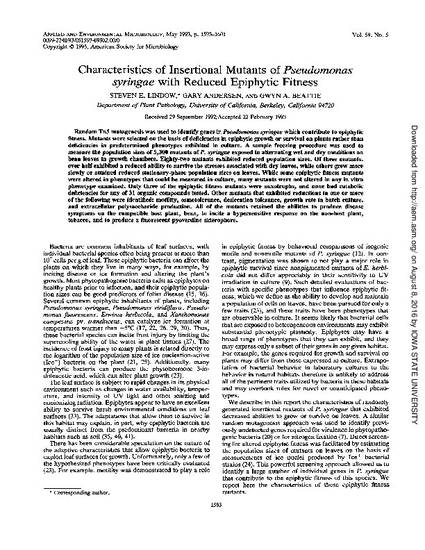
Article
Characteristics of Insertional Mutants of Pseudomonas syringae with Reduced Epiphytic Fitness
Applied and Environmental Microbiology
(1993)
Abstract
Random Tn5 mutagenesis was used to identify genes ir. Pseudomonas syringaewhich contribute to epiphytic fitness. Mutants were selected on the basis of deficiencies in epiphytic growth or survival on plants rather than deficiencies in predetermined phenotypes exhibited in culture. A sample freezing procedure was used to measure the population sizes of 5,300 mutants of P. syringae exposed to alternating wet and dry conditions on bean leaves in growth chambers. Eighty-two mutants exhibited reduced population sizes. Of these mutants, over half exhibited a reduced ability to survive the stresses associated with dry leaves, while others grew more slowly or attained reduced stationary-phase population sizes on leaves. While some epiphytic fitness mutants were altered in phenotypes that could be measured in culture, many mutants were not altered in any in vitro phenotype examined. Only three of the epiphytic fitness mutants were auxotrophs, and none had catabolic deficiencies for any of 31 organic compounds tested. Other mutants that exhibited reductions in one or more of the following were identified: motility, osmotolerance, desiccation tolerance, growth rate in batch culture, and extracellular polysaccharide production. All of the mutants retained the abilities to produce disease symptoms on the compatible host plant, bean, to incite a hypersensitive response on the non-host plant, tobacco, and to produce a fluorescent pyoverdine siderophore.
Disciplines
Publication Date
May, 1993
Publisher Statement
Copyright © 1993, American Society for Microbiology
Citation Information
Steven E. Lindow, Gary Andersen and Gwyn A. Beattie. "Characteristics of Insertional Mutants of Pseudomonas syringae with Reduced Epiphytic Fitness" Applied and Environmental Microbiology Vol. 59 Iss. 5 (1993) p. 1593 - 1601 Available at: http://works.bepress.com/gwyn-beattie/4/
